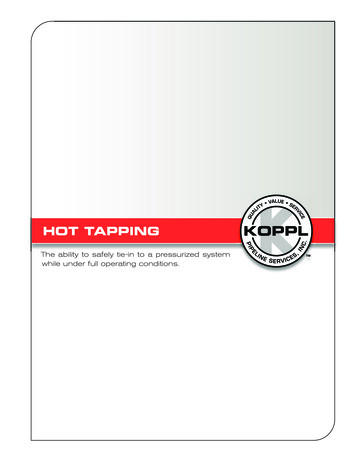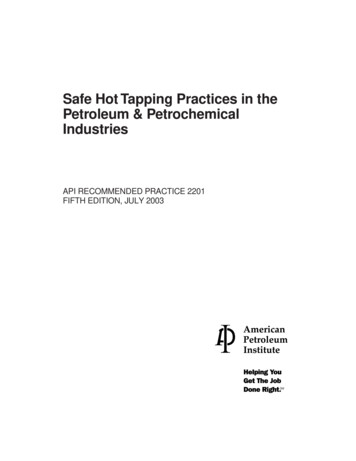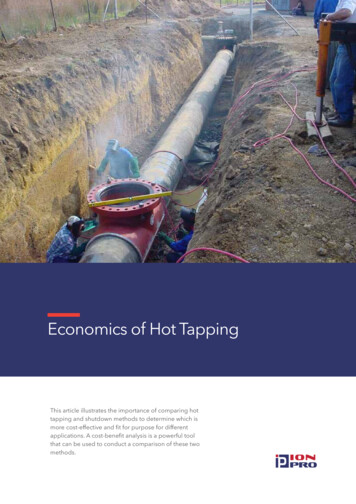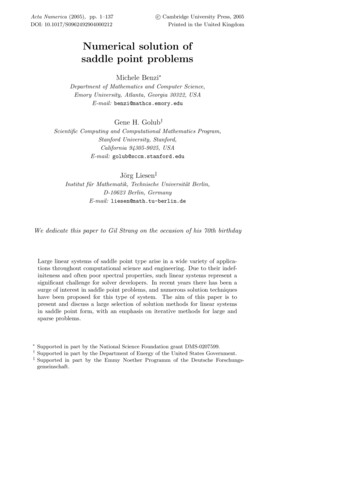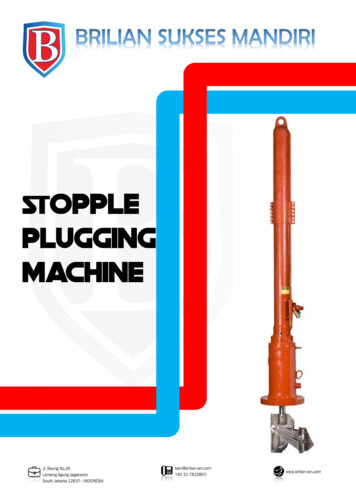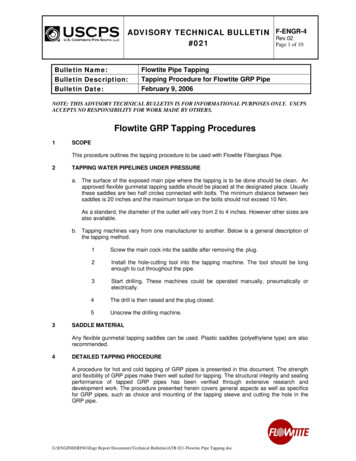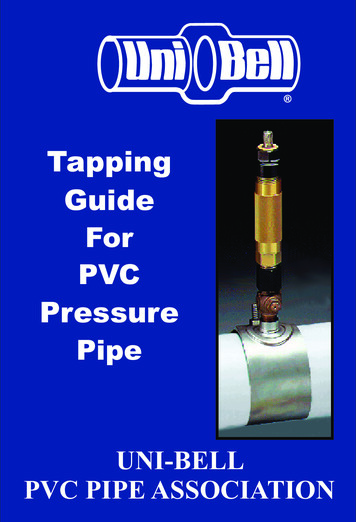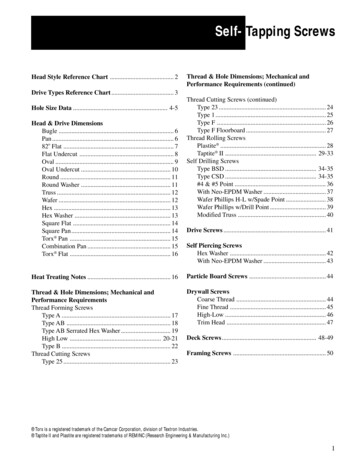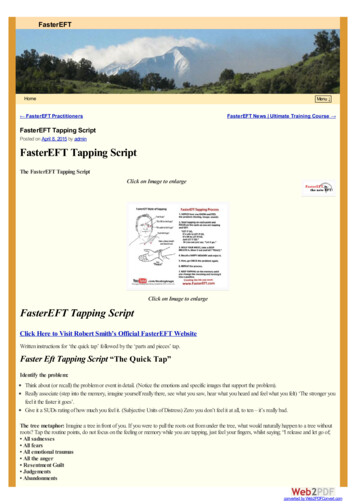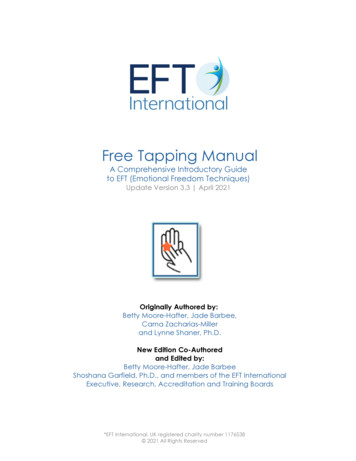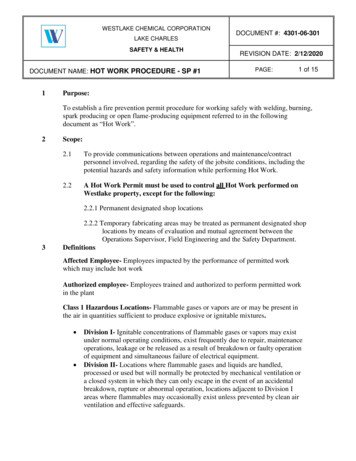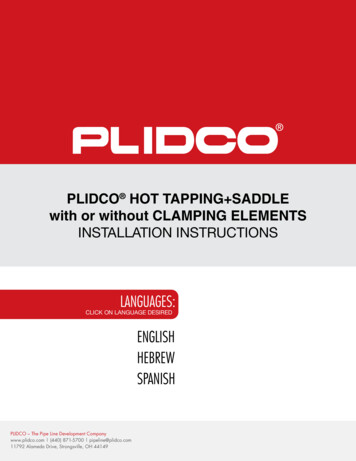
Transcription
PLIDCO HOT TAPPING SADDLEwith or without CLAMPING ELEMENTSINSTALLATION INSTRUCTIONSLANGUAGES:CLICK ON LANGUAGE DESIREDENGLISHHEBREWSPANISHPLIDCO – The Pipe Line Development Companywww.plidco.com (440) 871-5700 pipeline@plidco.com11792 Alameda Drive, Strongsville, OH 44149
The Pipe Line Development Company11792 Alameda Drive Strongsville, Ohio 44149Phone: (440) 871-5700 Fax: (440) 871-9577Toll Free: 1-800-848-3333web: www.plidco.com e-mail: pipeline@plidco.comPLIDCO HOT TAPPING SADDLEwith or without CLAMPING ELEMENTSINSTALLATION INSTRUCTIONS!! WARNING!!IMPROPER SELECTION OR USE OF THIS PRODUCT CAN RESULT INEXPLOSION, FIRE, DEATH, PERSONAL INJURY, PROPERTY DAMAGEAND/OR HARM TO THE ENVIRONMENT.Do not use or select a PLIDCO Hot Tapping Saddle until all aspects of the application are thoroughlyanalyzed. Do not use the PLIDCO Hot Tapping Saddle until you read and understand these installationinstructions. If you have any questions, or encounter any difficulties using this product, please contactPLIDCO.READ CAREFULLYThe person in charge of the hot tap operation must be familiar with these instructions and communicatethem to all personnel involved with the installation.Safety Check ListThe PLIDCO Hot Tapping Saddle may be used with the pipeline in operation or shut down.Consult the hot tap equipment manufacturer for their recommended procedures for hot tapping. Read and follow these instructions carefully. Follow your company's safety policy and applicablecodes and standards. If the Hot Tapping Saddle is to be installed underwater, be sure to read theUnderwater Installation section. Whenever a PLIDCO product is modified in any form, including adding a vent or changing seals,by anyone other than the Engineering and Manufacturing Departments of The Pipe LineDevelopment Company or a PLIDCO certified repacking company, the product warranty is voided.Products that are field modified do not have the benefit of the material traceability, proceduraldocumentation, quality inspection and experienced workmanship that are employed by The PipeLine Development Company. Observe the maximum allowable operating pressure (MAOP) and temperature on the label of thePLIDCO product. Do not exceed the MAOP or temperature as indicated on the unit. During the Pipe Preparation and Installation procedures, those installing the PLIDCO HotTapping Saddle must wear, at minimum, Z87 safety eyewear and steel toe safety footwear.Page 1 of 18IP-038Revision 2
Be absolutely certain that the correct seal material has been selected for the intended use.Contact PLIDCO or an authorized PLIDCO distributor if there are any questions about the sealcompatibility with the pipeline chemicals and temperatures. The PLIDCO Hot Tapping Saddle should never be used to couple pipe unless it was suppliedwith clamping elements designed specifically for that purpose. Consideration should be given tothe increased longitudinal stress imposed on the pipeline due to the hole cut into the pipe duringthe hot tapping operation. Valve and tapping equipment attached to the PLIDCO Hot Tapping Saddle may cause additionalloads and stresses on the fitting's branch. The fitting and tapping equipment may need to bebraced or supported against torsional or axial movement, particularly when hot tappinghorizontally. See the section on Hot Tapping Saddle Types or contact PLIDCO for further details. The PLIDCO Hot Tapping Saddle should be hydrostatically tested before tapping into thepipeline. Testing may be conducted through the branch connection or vent port if so equipped.The test pressure should not exceed the pressure of pipeline the fitting is installed on at the timeof testing. There is a danger of collapsing the pipe should this pressure be exceeded. See theRe-pressurizing & Field Testing. If the pipeline has been shut down, re-pressuring should be done with extreme caution. Repressuring should be accomplished slowly and steadily without surges that could vibrate thepipeline and fitting. Industry codes and standards are a good source of information on this subject.Except for testing purposes, do not exceed the design pressure of the PLIDCO HotTapping Saddle. Personnel should not be allowed near the repair until the seal has been proven.Hot Tapping Saddle TypesPLIDCO Hot Tapping Saddles come in 2 distinct types: Standard bolt-on & Structural with integralclamping elements. See Figures 1 & 2. It is important to understand the differences in application andinstallation procedures.Figure 1Figure 2Standard bolt-on fittings are meant for applications where there are no anticipated torsion or axial forcesacting on the fitting. There is little to no restraint on standard bolt-on hot taps, and the fitting may moveunless the forces that could cause the fitting to move are mitigated by some other means. SeparateClamp Rings or Strongbacks may be used in conjunction with standard bolt-on style HotTapping Saddles to mitigate extraneous forces.Structural hot taps have integral clamping elements. The clamping elements can be identified by thenotch in the sidebar and the metal sprayed bore. This type of hot tap has structural clamping elementsPage 2 of 18IP-038Revision 2
that prevent torsional or axial movement. Please verify that the restraint provided by the clampingelements is sufficient enough for the anticipated load. Listed below are several reasons why a PLIDCOHot Tapping Saddle may require integral clamping ends. This list is not inclusive and all applicationsshould be evaluated prior to use. Please contact PLIDCO if there are any questions regarding specificapplications.1. If a PLIDCO Hot Tapping Saddle is to be used for a plugging operation, the hydraulic forces actingon the plug can cause the PLIDCO Hot Tapping Saddle to move axially down the pipe. Thismovement could prevent the withdrawal on the plug. If this is the sole purpose of the clampingelements, a non-integral clamp/strongback may suffice. During an application involving a doubleplug and bypass, the direction of the hydraulic forces can be reversed when the isolated sectionof pipe is depressurized. For this type of application either two non-integral clamp rings or integralclamping elements should be utilized.2. If a PLIDCO Hot Tapping Saddle is to be used on a vertical pipe, integrated clamping elementsare recommended. A separate clamp or strongback may be used to support the weight of thesaddle and the tapping equipment depending on the forces and the direction. The weight of thetapping equipment, if not supported, can induce a bending moment on the pipe. To resist thebending moment integral clamping elements are recommended.3. If the tapping equipment is to be used horizontally and the weight of the tapping equipment couldcause the fitting to rotate around the pipe, integral clamping elements should be used.4. If there is concern that separation of the pipe will occur, whether it is due to the condition of thepipe or the amount of cross-sectional area removed by the coupon, integral clamping elementswill provide structural strength to the pipe and prevent separation.Pipe Preparation1.Remove all coatings, rust and scale from the pipe surface where the circumferential seals of thePLIDCO Hot Tapping Saddle will contact the pipe (see Figure 3). A near-white finish, as noted inSSPC-SP10 / NACE No.2, is preferred. The cleaner the pipe surface, the more positive the seal.2.Where the circumferential seals will contact any longitudinal, circumferential, or spiral pipe welds,the welds in this vicinity must be ground flush with the outside diameter of the pipe. The area shouldextend 1” (25mm) inside of the seals and 1” (25mm) beyond both ends of the fitting (see Figure 3).Circumferential pipe welds between the circumferential seals do not need to be ground flush as longas the weld height does not exceed 3/16 inch (4.7 mm) (see Figure 3). In addition, circumferentialwelds should be a minimum of 3” (76.2mm) from the hot tap branch.3.Figure 3Page 3 of 18IP-038Revision 2
4.Pipe outside diameter tolerance is 1% for 6-inch nominal pipe size and smaller. For pipe sizeslarger than 6-inch nominal, the tolerance is 0.06 inch ( 1.5 mm).5.The seal can tolerate minor surface irregularities up to 1/32 inch (0.8 mm) deep. The defectivesurfaces may be rendered suitable for sealing by applying a suitable epoxy such as Belzona 1161and sanding or filing the surface to match the required outer diameter.Note: Epoxy may only be applied to the area where the seals will land. It is not intended to rebuildthe pipe wall to the nominal OD, or to repair large sections of exterior corrosion.6.A PLIDCO Hot Tapping Saddle is capable of sealing on out-of-round pipe up to approximately 5%ovality. This is based on the ability of the bolting to reshape the pipe. For very thick wall pipe, thebolting may not be able to reshape the pipe. Severely out-of-round pipe may require repositioningthe PLIDCO Hot Tapping Saddle or using of a different length PLIDCO Hot Tapping Saddle toensure the circumferential seals are positioned on round pipe.7.A PLIDCO Hot Tapping Saddle is not capable of reshaping flattened or dented pipe.Lifting & HandlingWhen not being moved or transported on a pallet, PLIDCO Hot Tapping Saddles should always be lifted,transported, or installed using the installed lifting eyes as shown in Figure 4, when provided. If two liftingeyes per half are provided, both lifting eyes are required to lift the fitting. All Hot Tapping Saddles thatexceed 50 lbs. per half or are too heavy to move and install by hand are provided with lifting eyes oneach half with the exception of fittings with large flanges. If the Hot Tapping Saddle has a larger flange,it is acceptable to lift the fitting by the flange as shown in Figure 5. Care must be taken as to not damagethe flange face. Chains, hooks, shackles, or straps suitable for the weight of the fitting(s) shall be used,and must be securely inserted through the lifting eyes, flange stud holes, or around the flange.The lifting eyes are designed to support the weight of a fully assembled Hot Tapping Saddle. Liftingeyes are typically installed on the half of the fitting that does not contain the flange, and should be usedto maneuver or help lower Hot Tapping Saddle onto the pipeline.Vertical installations or installations that require special rigging due to space, obstructions, or locationmay require additional lifting eyes to be added in locations other than shown in Figures 4 & 5. Thesecan be added prior to ordering or sent back to a PLIDCO manufacturing facility to be added by PLIDCOpersonnel.Note: Careless handling can damage the seals and GirderRings (seal retainers). Lifting devices such aschains, cables, or straps should never contact the seals or GirderRings. Never lift the fitting byinserting the forks from a fork lift inside of the fitting. Contact on the seals or GirderRings can resultin the seals being pulled from their grooves. (See Figure 6)Page 4 of 18IP-038Revision 2
Figure 4Figure 5Figure 6InstallationThe following sections define the general procedure for installation of a PLIDCO Hot Tapping Saddleonto a pipeline. Hot Tapping Saddles with and without integral clamping elements are detailed inseparate sections. Please refer to Figure 1 & 2 to identify the type of PLIDCO Hot Tapping Saddle beinginstalled.Note: These installation instructions do not address the hot tapping machine installation onto the branchor the hot tapping process. Please refer to the manufacturer’s hot tapping machine’s installation andoperation instructions.Page 5 of 18IP-038Revision 2
Standard PLIDCO Hot Tapping Saddle InstallationThis section details the installation procedure for standard bolt on PLIDCO Hot Tapping Saddlewithout clamp ends as shown in Figure 7.Figure 71.If the two sleeve halves were shipped as an assembled unit, it would have been shipped withspacers between the two halves to prevent damage to the longitudinal seals and ends of thecircumferential seals. Typically, small diameter nuts are used for the spacers. The spacers mustbe removed and discarded before installing the PLIDCO Hot Tapping Saddle. Failure to removethe spacers will prevent proper compression of the seals.2.Coat all exposed surfaces of elastomer seals with a lubricant. Table 1 lists the lubricants that arerecommended for the various seals. The customer must determine if the lubricant is compatiblewith the product in the pipeline. Lubricant is not recommended for underwater installations orbraided packing. Refer to the section on Underwater Installations.Petroleum based lubricantsSilicone based lubricantsGlycerin based lubricantsSuper Lube Grease (1) A B C DTemperature (2)Buna-NA, B, C, D225 F (107 C)VitonA, B, C, D250 F (121 C)SiliconeC, D300 F (149 C)NeopreneB, C, D250 F (121 C)AflasA, B, C, D225 F (107 C)HycarA, B, C, D180 F (82 C)Super Lube Grease is a product of Synco ChemicalCorporation. (www.super-lube.com)Temperature limit is for the seal material only and does not implythe pressure rating is necessarily applicable at this limit.Table 1: Approved LubricantsPage 6 of 18IP-038Revision 2
3.Clean and lubricate all studs and nuts. Verify that each nut threads on freely prior to the installation.Lubricant is not recommended for underwater installations.Note: The type of lubricant will dictate the torque value per the PLIDCO torque chart on pages 17& 18.4.Assemble the PLIDCO Hot Tapping Saddle around the pipe making sure the yellow painted endsare matched and that the fitting is centered over the area to be hot tapped as shown in Figure 3.5.Install the studs and nuts through the holes in the Hot Tapping Saddles as shown in Figure 7. MostHot Taps will have two different stud lengths. Make sure the longer studs are in the proper boltholes. PLIDCO Hot Tapping Saddles with 3 holes per side should have the longer bolts in the twocenter holes. Hot Taps with more than 3 holes per side should have the longer bolts in the fourcorner holes
the hot tapping operation. Valve and tapping equipment attached to the PLIDCO Hot Tapping Saddle may cause additional loads and stresses on the fitting's branch. The fitting and tappingequipment may need to be braced or supported against torsional or axial movement, particularly when hot tapping horizontally. See the section on
